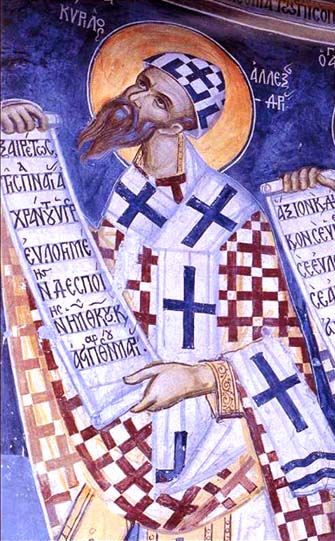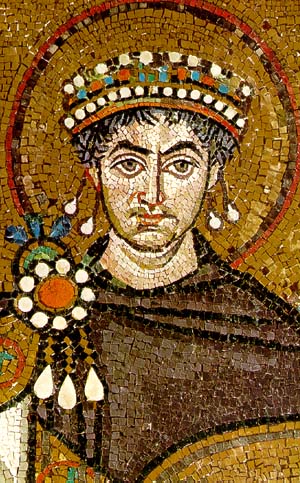 |
|
 |
|
Cyril of
Alexandria, Fresco, Cyprus, 16th c. |
Pope Leo the Great, Algardi, Rome |
Justinian, St. Vitale, Ravenna |
eo
CHRISTOLOGICAL
CONTROVERSIES
and
COUNCILS: 431-553
 |
|
 |
|
Cyril of
Alexandria, Fresco, Cyprus, 16th c. |
Pope Leo the Great, Algardi, Rome |
Justinian, St. Vitale, Ravenna |
THE inordinate fascination, bordering on obsession, of Eastern Christians with theological minutiae is well described by Gregory of Nyssa. What he says in regard to Arianism at the end of the fourth century would hold true for the Christological controversies of the fifth and sixth centuries, as well:
| THE whole city is full of it, the squares, the marketplaces, the crossroads, the alleyways; rag dealers, money-changers, food-sellers, they are all busy arguing. | Πάντα γὰρ τὰ κατὰ τὴν πόλιν τῶν τοιούτων πεπλήρωται͵ οἱ στενωποὶ͵ αἱ ἀγοραὶ͵ αἱ πλατεῖαι͵ τὰ ἄμφοδα· οἱ τῶν ἱματίων κάπηλοι͵ οἱ ταῖς τραπέζαις ἐφεστη κότες͵ οἱ τὰ ἐδώδιμα ἡμῖν ἀπεμπολοῦντες. |
| If you ask someone to give you change, he philosophizes about the Begotten and the Unbegotten; if you inquire about the price of a loaf, you are told that the Father is greater and the Son lesser; if you ask, “Is my bath ready?” the attendant answers that the Son was made out of nothing. | Ἐὰν περὶ τῶν ὀβολῶν ἐρωτήσῃς͵ ὁ δέ σοι περὶ γεννητοῦ καὶ ἀγεννήτου ἐφιλοσόφησε· κἂν περὶ τιμήματος ἄρτου πύθοιο͵ Μείζων ὁ Πατὴρ͵ ἀποκρίνεται͵ καὶ ὁ Υἱὸς ὑποχείριος. Εἰ δὲ͵ Τὸ λουτρὸν ἐπιτήδειόν ἐστιν͵ εἴποις͵ ὁ δὲ ἐξ οὐκ ὄντων τὸν Υἱὸν εἶναι διωρίσατο. |
|
On the Deity of the Son PG 46,557b |
THE Christological controversies of the fifth and sixth centuries reflect a tension between two complimentary but, sadly, rival schools of theology and exegesis.
ANTIOCHENE theology, is represented by Diadorus of Tarsus (bp.378-c.390), his student, the great exegete Theodore of Mopsuestia (c.350-428) and Theodore's saintly but less able (and much-execrated) disciple, Nestorius (bp.c.351-c.452). Antiochene exegesis emphasized the literal interpretation of biblical texts: Antiochene Christology emphasized the distinction between the humanity and the divinity of Christ. Antiochene exegetes were fond of attributing certain acts of Christ to his divinity (such as miracles) and others to his humanity (such as suffering). It its extreme, heretical form “Nestorianism” overemphasized the distinction and separation between Christ’s natures, implying that Christ was not a single “person”, and refusing to admit that the Word of God suffered and died for us, or (more famously) that the Blessed Virgin Mary may be called Theotokos, God-bearer.
ALEXANDRIAN theologians regarded themselves as the successors of St. Athanasius (c.296-373); however their chief spokesman was St. Cyril of Alexandria (bp. 412-444). Their exegetes traditionally prefered spiritual allegory to literal history; and their Christology emphasized the divinity of Christ and the union in Christ of the divine and human natures. The extreme form of this approach is represented by the Archimandrite Eutyches’ (c.378-454) “monophysitism”, the conviction that after the Incarnation one must speak of only one nature (physis) in Christ.
This Webpage was created for a workshop held at Saint Andrew's Abbey, Valyermo, California in 1998
xxxx» cont
xcxxcxxc